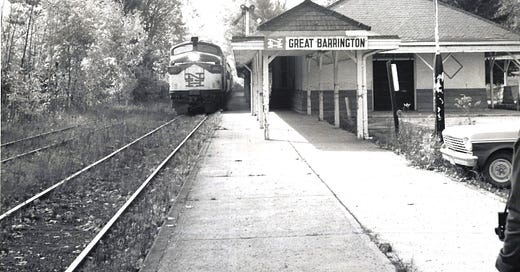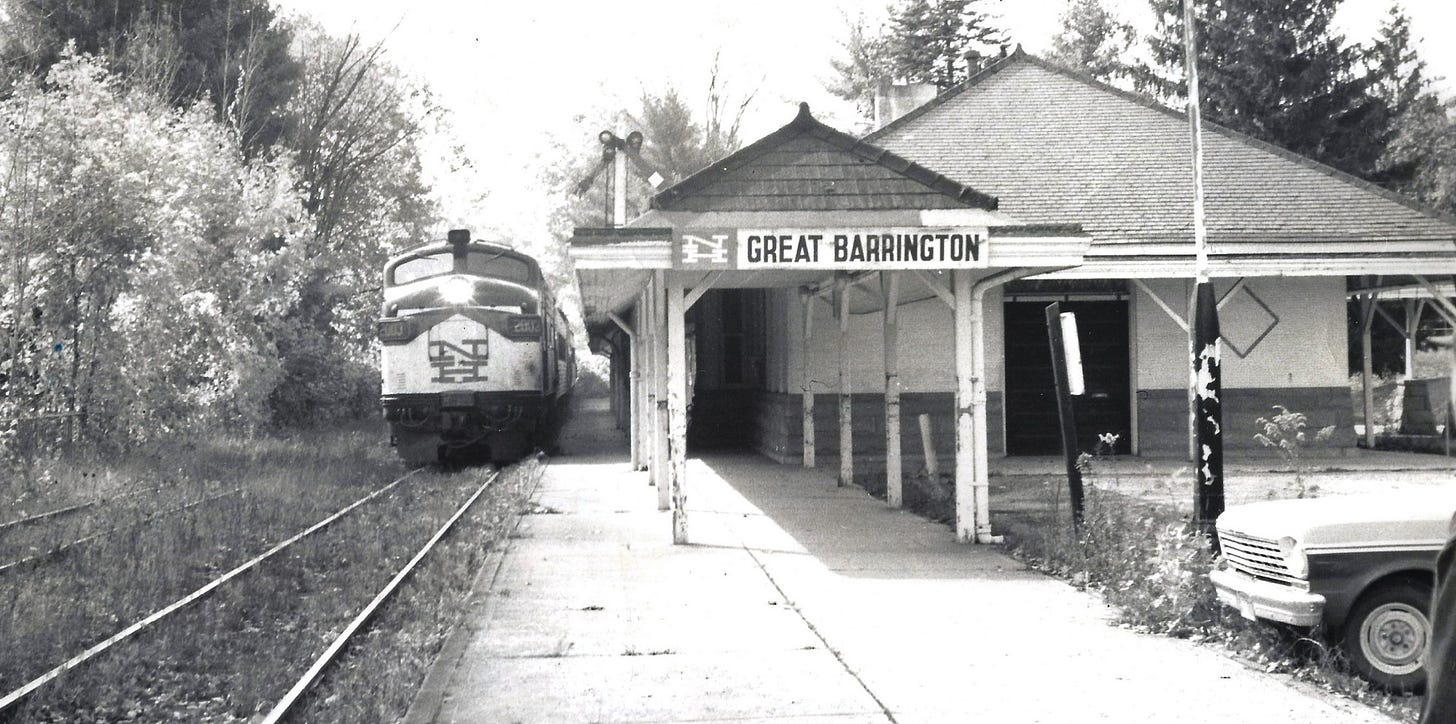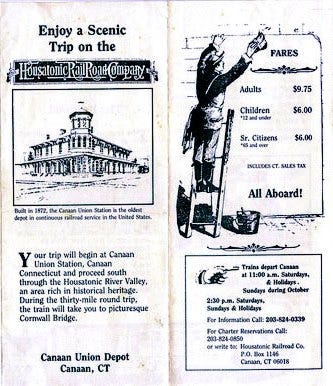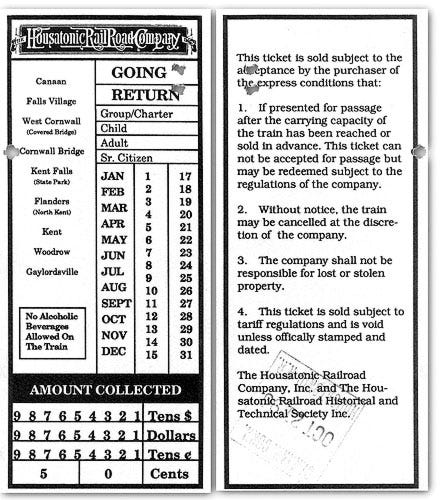Housatonic event today and Housatonic Line history
And news about my forthcoming trip to China
I’ll be going to China next month! In a sense, that’s where the Train Campaign began, as you can read here. and I am hoping to take the train for part of the jorney to Dunhuang, in the western province of Gansu. (Want to learn more about China’s trains? Here’s a video. The maps are spectacular but there is more to the story, and I hope to get a first-hand look.)
This afternoon you can hear about the music inspired by railroads at the Ramsdell Library in Housatonic. The program is free.
And as background to our forthcoming posts about the Housatonic (or Berkshire) Line, I’ve pulled up some history, which may surprise you as much as it did me. It was fun to see that one of the New York Times stories was written by Jim Brooke, who now lives in Lenox and writes an insightful series about the war in Ukraine, drawing on his years as a reporter in Ukraine and Russia.
1942: “First train reached here exactly 100 years ago”
1985: “Retracing history at 10 MPH”
By James Brooke, Oct. 6, 1985, New York Times (gift link)
For people who race through cities all week long, the Housatonic Railroad offers a weekend amble through lush greenery and 19th-century history at speeds guaranteed not to break 10 miles an hour. At that pace, passengers have time to contemplate stone walls coursing through dense woods, flowers tumbling down river banks and canoeists negotiating Housatonic River rapids.
After a 10-year hiatus, rail passenger service returned last summer to the Housatonic line, which runs north and south through one of Connecticut's most scenic areas, Litchfield County. Designed as a half-day trip for weekend excursionists, the line links Canaan and West Cornwall, two villages filled with boutiques and restaurants.
Last year, another sightseeing train, the Berkshire Scenic Railroad, began service on the Housatonic line in Massachusetts, from Lee to Great Barrington.
The Litchfield trip starts at Canaan Union Station, an 1872 Victorian structure listed on the National Register of Historic Places. The station was built the year after tracks for an east-west line, the Central New England, were laid through Canaan, forming a union with the Housatonic Railroad.
Tickets can be purchased at the old office, operating once again at the base of the station's octagonal spotting tower. Designed at a time when the human eye was trusted more than the telegraph line, the tower was situated so an observer could sight down all four lines of track to prevent collisions. Although virtually abandoned a decade ago, Canaan Junction during its busiest era at the turn of the century saw 36 trains a day pass through. Freshly painted last summer, the ticket office now houses a museum displaying old train maps, photographs, telegraph keys and brass baggage tags. The office is staffed by volunteers, many of whom worked long hours over the last three years to reclaim 13 miles of the line from rampant underbrush.
''I had to get down on my hands and knees and crawl under the fallen trees,'' John R. Hanlon Jr., president of the Housatonic Railroad Company, said of his first track inspection in 1982. The track was abandoned about 10 years ago by Penn Central, which later sold it to the state of Connecticut, which in turn leases it to Mr. Hanlon's fledgling railroad.
A broad-shouldered man with a bushy, chestnut beard and a determined air, Mr. Hanlon plans to soldier on, clearing all 34 miles of track from Canaan south to New Milford, which is currently served by freight trains from Danbury. By next year he plans to expand service to Kent, 25 miles south of Canaan.
Read the whole story in the New York Times (gift link).
1991: The Housatonic, the Little Railroad That Could, and Did
By Randall Beach, Feb. 10, 1991, New York Times (gift link)
NINE years ago, John Hanlon Jr. heard about an overgrown, abandoned railroad line from New Milford to Canaan. With an entrepreneur's vision, he imagined the tracks cleared and trains again bringing passengers and freight from northwest Connecticut to Manhattan.
"It just seemed like a good thing to do," said Mr. Hanlon, a custom-car designer. "This is an efficient form of transportation. I figured that sooner or later, it would come back."
And it has. In a time of soaring gasoline prices and congested highways, Americans are rediscovering railroads, and Mr. Hanlon's Housatonic Railroad Company, based in Canaan, is already profitable, he said.
Since he formed the company in 1983, he has restored those 35 miles of track, transported tens of thousands of enchanted tourists on scenic weekend runs from Canaan to Cornwall Bridge and reinstituted freight service for two companies in Canaan, Becton Dickinson, the medical supply company, and the Pfizer limestone quarry. The Interstate Commerce Commission recently approved Mr. Hanlon's bid to purchase 36 miles of track from Canaan to Pittsfield, Mass., that was formerly owned by Guilford Transportation Industries.
Mr. Hanlon said he hopes to buy Conrail's track from New Milford to Danbury. His ultimate goal, he said, is passenger service seven days a week from Pittsfield to Danbury, with a link to Metro-North trains to Manhattan. If he is successful, it will be the first time since 1971 that residents of the northwest hills of Connecticut, including Litchfield County, will be able to ride a train to New York.
Read the whole story in the New York Times (gift link).
Thanks to our sponsors and supporting subscribers!
All content in Train Time is shared under a Creative Commons License (CC BY-NC-ND):
Attribution (BY) – Always credit the author and Train Time as the original creator with a tag or link to https://traintime.substack.com.
Non-Commercial (NC) – Content cannot be used for commercial purposes.
No Derivatives (ND) – Content may not be modified, adapted, or repurposed.










Illustrated article about the Housatonic Railroad today by Dave Jacobs in Railfan magazine. https://railfan.com/housatonic-today/